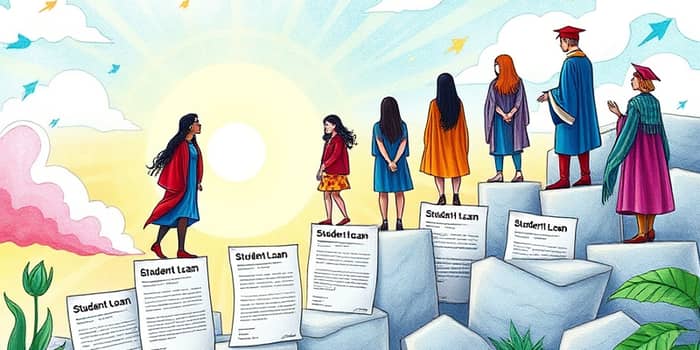Every year, millions of graduates face the reality of repaying their education costs. The weight of these obligations can feel insurmountable, shaping career choices and personal dreams. Yet, within this challenge lies opportunity. With knowledge and planning, borrowers can transform repayment from a burden into a path toward lifelong financial confidence and freedom.
Understanding the landscape and using proven strategies will instill hope and control over what once seemed overwhelming. This article offers a comprehensive guide to navigate the complexities of student loans in 2025 and beyond.
The Current Landscape of Student Debt
As of 2025, total student loan debt in the United States stands at a staggering 1.81 trillion dollars, with federal loans accounting for 1.67 trillion. Approximately 42.3 million Americans carry federal loan balances. This debt spans all ages, from recent graduates to midcareer professionals, reflecting a broad societal challenge.
Among these borrowers, 52 percent are over 35 years old, and 20 percent are over 50. The average balance per borrower exceeds 39,000 dollars. High-debt borrowers—those owing more than 100,000 dollars—number 3.6 million. Delinquency rates hover around 11.3 percent for federal loans and 1.6 percent for private loans, underscoring an overwhelming sense of burden that many feel daily.
Federal Repayment Plan Options
The Department of Education offers several plans designed to help borrowers align payments with income and life stage. Understanding each option is crucial to choosing the best path for your unique situation.
tailored repayment structure by income gives borrowers flexibility and security when steady budgets are a priority. Standard plans fix payments over ten years, while graduated plans start lower and rise over time. Income-driven plans, including the SAVE plan, base payments on earnings and family size, offering relief when paychecks fluctuate.
Forgiveness and Relief Programs
Borrowers in certain public service roles or those on income-driven plans may qualify for significant relief. Public Service Loan Forgiveness allows for complete cancellation after 120 qualifying payments under eligible employment. Teacher Loan Forgiveness can grant up to 17,500 dollars for educators in low-income schools. Income-driven repayment forgiveness kicks in after 20 to 25 years of payments, with recent adjustments accelerating timelines for many.
Knowing your eligibility can open doors to eliminate remaining balance after payment obligations, easing long-term financial strain.
Strategies for Smarter Repayment
Facing student loans with an active plan can accelerate your journey toward debt freedom. Implementing these tactics can shorten terms and save thousands in interest.
- Make extra payments when possible, even a small amount such as fifty dollars can lead to reduced interest and shorter repayment.
- Switch to biweekly payments to create a thirteenth payment each year, cutting months off your loan term.
- Enroll in autopay to earn a 0.25 percent interest rate discount with many servicers.
- Consider refinancing only if you have excellent credit and stable income, mindful of losing federal protections.
- Adopt the debt avalanche method by prioritizing the highest interest rates first while maintaining minimums on other loans.
Employer-Related Repayment Support
Many employers now offer student loan assistance as a benefit, up to 5,250 dollars per year, tax-free. Innovative programs even match loan payments with retirement contributions, ensuring both debt reduction and long-term savings.
- Check if your company offers direct loan repayment benefits for employees.
- Explore programs that tax-free assistance for loan repayment enhances overall compensation.
- Combine employer benefits with personal strategies for maximum impact.
Demographics and Impact
Student loan debt affects borrowers of every background. Twenty percent of adults with a bachelor’s degree still carry balances, while 24 percent of postgraduates are indebted. Delinquency disproportionately affects Black and Hispanic borrowers and those with lower incomes or attendance at for-profit institutions.
Regional variations also shape monthly payments, ranging from 142 dollars in Mississippi to 248 dollars in Vermont. Recognizing these patterns can help communities and policymakers tailor support where it is needed most.
Expert Tips and Recommendations
- Track your loan servicer contact details, balances, and interest rates in one accessible location.
- Use online calculators to compare repayment plan scenarios and refinancing outcomes.
- Set realistic budgets and build emergency savings alongside loan repayment.
- Review federal policy updates regularly to take advantage of new relief measures and plan adjustments.
- Consult a financial advisor to align repayment with long-term goals and investments.
This clear and structured information empowers borrowers to make informed choices and maintain confidence in their financial journey.
Recent Policy Changes and Trends
The IDR account adjustment of 2024 has reshaped forgiveness timelines for many borrowers, while the updated SAVE plan offers new income-based benefits. Employers continue to expand loan assistance, and legislative efforts may extend tax-free benefits beyond 2025. Staying informed ensures you can leverage every available opportunity.
Summary of Repayment Strategies
By embracing these strategies, borrowers can reclaim control over their finances and transform debt repayment from a source of anxiety into a structured journey toward freedom.
References
- https://www.ameriprise.com/financial-goals-priorities/personal-finance/how-to-manage-student-loan-debt
- https://educationdata.org/student-loan-debt-statistics
- https://myvetlife.avma.org/rising-professional/your-financial-health/loan-repayment-strategies
- https://www.bestcolleges.com/research/average-student-loan-debt/
- https://www.afcpe.org/event/fpa-connect-mastering-student-loan-repayment-in-2025-expert-strategies-for-financial-success/
- https://www.livenowfox.com/news/student-loan-payments-by-states
- https://www.accesslex.org/tools-and-resources/road-zero-strategic-approach-student-loan-repayment
- https://www.federalreserve.gov/publications/2025-economic-well-being-of-us-households-in-2024-higher-education-and-student-loans.htm
- https://www.paycor.com/resource-center/articles/employer-student-loan-repayment-program-5-tips/
- https://www.newyorkfed.org/microeconomics/topics/student-debt
- https://studentaid.gov/manage-loans/repayment/plans
- https://usatodayreport.com/top-5-student-loan-repayment-shifts-impacting-the-u-s-in-2025/
- http://www.ed.gov/about/news/press-release/us-department-of-education-continues-improve-federal-student-loan-repayment-options-addresses-illegal-biden-administration-actions
- https://www.winssolutions.org/us-student-loan-statistics-2025/
- https://studentaid.gov/manage-loans/repayment/repaying-101
- https://studentaid.gov/announcements-events/idr-account-adjustment
- https://fsapartners.ed.gov/knowledge-center/library/electronic-announcements/2025-07-23/nonpayment-rates-institution-default-prevention-resource-nslds-delinquent-borrower-report










